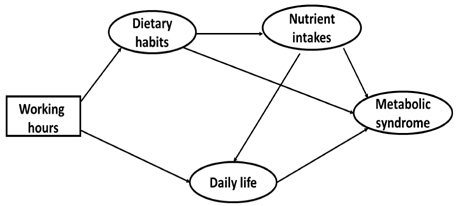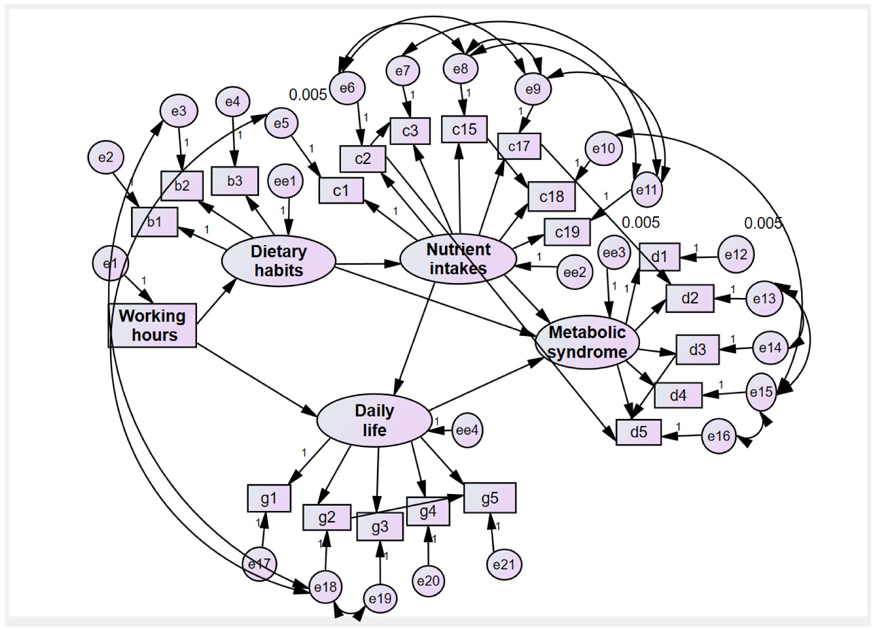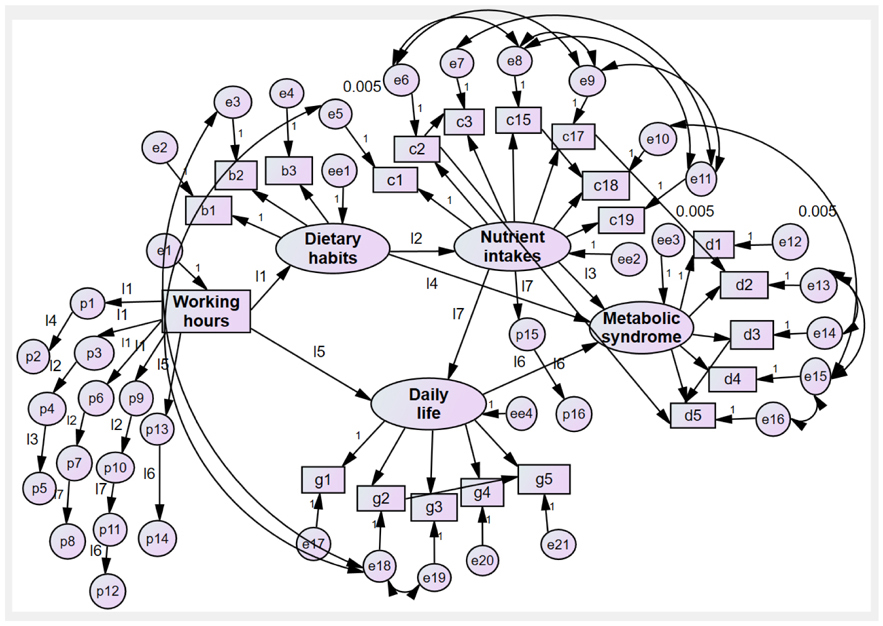J Nutr Health.
2018 Dec;51(6):567-579. 10.4163/jnh.2018.51.6.567.
Mediation analysis of dietary habits, nutrient intakes, daily life in the relationship between working hours of Korean shift workers and metabolic syndrome : the sixth (2013 ~ 2015) Korea National Health and Nutrition Examination Survey
- Affiliations
-
- 1Department of Food and Nutrition/Institute of Agriculture and Life Science, Gyeongsang National University, Jinju, Gyeongnam 52828, Korea.
- 2Department of Information & Statistics and RINS, Gyeongsang National University, Jinju, Gyeongnam 52828, Korea. dhlim@gnu.ac.kr
- KMID: 2455844
- DOI: http://doi.org/10.4163/jnh.2018.51.6.567
Abstract
- PURPOSE
This study examined the mediation effects of dietary habits, nutrient intake, daily life in the relationship between the working hours of Korean shift workers and metabolic syndrome.
METHODS
Data were collected from the sixth (2013-2015) Korea National Health and Nutrition Examination Survey (KNHANES). The stochastic regression imputation was used to fill missing data. Statistical analysis was performed in Korean shift workers with metabolic syndrome using the SPSS 24 program for Windows and a structural equation model (SEM) using an analysis of moment structure (AMOS) 21.0 package.
RESULTS
The model fitted the data well in terms of the goodness of fit index (GFI) = 0.939, root mean square error of approximation (RMSEA) = 0.025, normed fit index (NFI) = 0.917, Tucker-Lewis index (TLI) = 0.984, comparative fit index (CFI) = 0.987, and adjusted goodness of fit index (AGFI) = 0.915. Specific mediation effect of dietary habits (p = 0.023) was statistically significant in the impact of the working hours of shift workers on nutrient intake, and specific mediation effect of daily life (p = 0.019) was statistically significant in the impact of the working hours of shift workers on metabolic syndrome. On the other hand, the dietary habits, nutrient intake and daily life had no significant multiple mediator effects on the working hours of shift workers with metabolic syndrome.
CONCLUSION
The appropriate model suggests that working hours have direct effect on the daily life, which has the mediation effect on the risk of metabolic syndrome in shift workers.
Figure
Cited by 1 articles
-
The Association between the Type and Level of Physical Activity and Metabolic Syndrome in Korean Adults Aged 40 Years and over: Results from the Eighth Korea National Health and Nutrition Examination Survey (2019–2021)
Namkuk Son
Korean J Sports Med. 2024;42(2):145-153. doi: 10.5763/kjsm.2024.42.2.145.
Reference
-
1. Eckel RH, Grundy SM, Zimmet PZ. The metabolic syndrome. Lancet. 2005; 365(9468):1415–1428.
Article2. Mottillo S, Filion KB, Genest J, Joseph L, Pilote L, Poirier P, Rinfret S, Schiffrin EL, Eisenberg MJ. The metabolic syndrome and cardiovascular risk a systematic review and meta-analysis. J Am Coll Cardiol. 2010; 56(14):1113–1132.3. Suh S, Lee MK. Metabolic syndrome and cardiovascular diseases in Korea. J Atheroscler Thromb. 2014; 21:Suppl 1. S31–S35.
Article4. Baek JH, Kim H, Kim KY, Jung J. Insulin resistance and the risk of diabetes and dysglycemia in Korean general adult population. Diabetes Metab J. 2018; 42(4):296–307.
Article5. Lim S, Shin H, Song JH, Kwak SH, Kang SM, Yoon JW, Choi SH, Cho SI, Park KS, Lee HK, Jang HC, Koh KK. Increasing prevalence of metabolic syndrome in Korea: the Korean National Health and Nutrition Examination Survey for 1998-2007. Diabetes Care. 2011; 34(6):1323–1328.
Article6. Knutsson A. Methodological aspects of shift-work research. Chronobiol Int. 2004; 21(6):1037–1047.
Article7. Szosland D. Shift work and metabolic syndrome, diabetes mellitus and ischaemic heart disease. Int J Occup Med Environ Health. 2010; 23(3):287–291.
Article8. Lee S, McCann D, Messenger JC. Working Time Around the World. Abingdon: Routledge;2007.9. Chen JD, Lin YC, Hsiao ST. Obesity and high blood pressure of 12-hour night shift female clean-room workers. Chronobiol Int. 2010; 27(2):334–344.
Article10. Hansen AB, Stayner L, Hansen J, Andersen ZJ. Night shift work and incidence of diabetes in the Danish Nurse Cohort. Occup Environ Med. 2016; 73(4):262–268.
Article11. Park S, Nam J, Lee JK, Oh SS, Kang HT, Koh SB. Association between night work and cardiovascular diseases: analysis of the 3rd Korean working conditions survey. Ann Occup Environ Med. 2015; 27(1):15.
Article12. Vetter C, Devore EE, Wegrzyn LR, Massa J, Speizer FE, Kawachi I, Rosner B, Stampfer MJ, Schernhammer ES. Association between rotating night shift work and risk of coronary heart disease among women. JAMA. 2016; 315(16):1726–1734.
Article13. Proper KI, van de, Rodenburg W, Vermeulen RC, van der Beek AJ, van Steeg H, van Kerkhof LW. The relationship between shift work and metabolic risk factors: a systematic review of longitudinal studies. Am J Prev Med. 2016; 50(5):e147–e157.14. Nam ES, Kim Y, Ki YS. Comparison study of working pattern and the prevalence of metabolic syndrome among Korean adults: using the 2011-2014 Korea National Health and Nutrition Examination Survey. Korean J Fam Pract. 2017; 7(6):933–940.
Article15. Vimalananda VG, Palmer JR, Gerlovin H, Wise LA, Rosenzweig JL, Rosenberg L, Ruiz Narváez EA. Night-shift work and incident diabetes among African-American women. Diabetologia. 2015; 58(4):699–706.
Article16. Ika K, Suzuki E, Mitsuhashi T, Takao S, Doi H. Shift work and diabetes mellitus among male workers in Japan: does the intensity of shift work matter? Acta Med Okayama. 2013; 67(1):25–33.17. Suwazono Y, Sakata K, Okubo Y, Harada H, Oishi M, Kobayashi E, Uetani M, Kido T, Nogawa K. Long-term longitudinal study on the relationship between alternating shift work and the onset of diabetes mellitus in male Japanese workers. J Occup Environ Med. 2006; 48(5):455–461.
Article18. Morikawa Y, Nakagawa H, Miura K, Soyama Y, Ishizaki M, Kido T, Naruse Y, Suwazono Y, Nogawa K. Shift work and the risk of diabetes mellitus among Japanese male factory workers. Scand J Work Environ Health. 2005; 31(3):179–183.
Article19. Jeong JU, Jeon MJ, Sakong J. The association between long working hours and the metabolic syndrome: evidences from the 5th Korean National Health and Nutrition Examination Survey of 2010 and 2012. Ann Occup Environ Med. 2014; 26:53.
Article20. Yu J. Relationship between long working hours and metabolic syndrome among Korean workers. Asian Nurs Res (Korean Soc Nurs Sci). 2017; 11(1):36–41.
Article21. Baraldi AN, Enders CK. An introduction to modern missing data analyses. J Sch Psychol. 2010; 48(1):5–37.
Article22. Lim D. AMOS 24: Structural Equation Modeling. Paju: Freedom Academy;2017.23. Alberti KG, Eckel RH, Grundy SM, Zimmet PZ, Cleeman JI, Donato KA, Fruchart JC, James WP, Loria CM, Smith SC Jr. International Diabetes Federation Task Force on Epidemiology and Prevention. Hational Heart, Lung, and Blood Institute. American Heart Association. World Heart Federation. International Atherosclerosis Society. International Association for the Study of Obesity. Harmonizing the metabolic syndrome: a joint interim statement of the International Diabetes Federation Task Force on Epidemiology and Prevention; National Heart, Lung, and Blood Institute; American Heart Association; World Heart Federation; International Atherosclerosis Society; and International Association for the Study of Obesity. Circulation. 2009; 120(16):1640–1645.24. World Health Organization Western Pacific Region. International Association for the Study of Obesity. International Obesity TaskForce. The Asia-Pacific Perspective: Redefining Obesity and Its Treatment. Sydney: Health Communications Australia;2000.25. Larwin K, Harvey M. A demonstration of a systematic item-reduction approach using structural equation modeling. Pract Assess, Res Eva. 2012; 17(8):1–19.26. Bae B. Structural Equation Modeling with AMOS 24. Seoul: Chung Ram;2017.27. Gupta A, Gupta V. Metabolic syndrome: what are the risks for humans? Biosci Trends. 2010; 4(5):204–212.28. Akbaraly TN, Kivimäki M, Brunner EJ, Chandola T, Marmot MG, Singh-Manoux A, Ferrie JE. Association between metabolic syndrome and depressive symptoms in middle-aged adults: results from the Whitehall II study. Diabetes Care. 2009; 32(3):499–504.
Article29. Marazziti D, Rutigliano G, Baroni S, Landi P, Dell'Osso L. Metabolic syndrome and major depression. CNS Spectr. 2014; 19(4):293–304.
Article30. Virtanen M, Ferrie JE, Akbaraly T, Tabak A, Jokela M, Ebmeier KP, Singh-Manoux A, Kivimäki M. Metabolic syndrome and symptom resolution in depression: a 5-year follow-up of older adults. J Clin Psychiatry. 2017; 78(1):e1–e7.31. Lowden A, Moreno C, Holmbäck U, Lennernäs M, Tucker P. Eating and shift work - effects on habits, metabolism and performance. Scand J Work Environ Health. 2010; 36(2):150–162.
Article32. Engin A. Circadian rhythms in diet-induced obesity. Adv Exp Med Biol. 2017; 960:19–52.
Article33. Bonham MP, Bonnell EK, Huggins CE. Energy intake of shift workers compared to fixed day workers: a systematic review and meta-analysis. Chronobiol Int. 2016; 33(8):1086–1100.
Article34. Min C, Noh H, Kang YS, Sim HJ, Baik HW, Song WO, Yoon J, Park YH, Joung H. Skipping breakfast is associated with diet quality and metabolic syndrome risk factors of adults. Nutr Res Pract. 2011; 5(5):455–463.
Article35. Smith KJ, Gall SL, McNaughton SA, Blizzard L, Dwyer T, Venn AJ. Skipping breakfast: longitudinal associations with cardiometabolic risk factors in the Childhood Determinants of Adult Health Study. Am J Clin Nutr. 2010; 92(6):1316–1325.
Article36. Kim S, DeRoo LA, Sandler DP. Eating patterns and nutritional characteristics associated with sleep duration. Public Health Nutr. 2011; 14(5):889–895.
Article37. Kim NH, Shin DH, Kim HT, Jeong SM, Kim SY, Son KY. Associations between metabolic syndrome and inadequate sleep duration and skipping breakfast. Korean J Fam Med. 2015; 36(6):273–277.
Article38. Arendt J. Shift work: coping with the biological clock. Occup Med (Lond). 2010; 60(1):10–20.
Article
- Full Text Links
- Actions
-
Cited
- CITED
-
- Close
- Share
- Similar articles
-
- Working hours and the regulations for night shift workers
- Effect of Nutrition Education on Improving Dietary Attitudes, Food Habits and Food Frequency - Female in Twenties Shift Work in Gyeonggi Area
- Relationship Between Long Working Hours and Metabolic Syndrome Among Korean Workers
- Metabolic Syndrome Status of Chinese Workers and Their Physical Profiles, Lifestyle Scores, and Nutrient Intakes
- Dietary Behaviors and Dietary Quality are Determined by the Working Hours of Industrial Male Workers Working in Rotating Shifts




